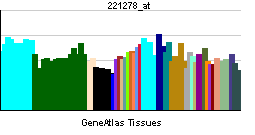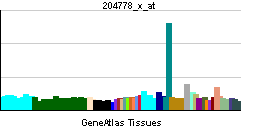HOXB8
| Homeobox B8 | |||||||||||
|---|---|---|---|---|---|---|---|---|---|---|---|
| Identifiers | |||||||||||
| Symbols | HOXB8 ; HOX2; HOX2D; Hox-2.4 | ||||||||||
| External IDs | Template:OMIM5 Template:MGI HomoloGene: 7768 | ||||||||||
| |||||||||||
| RNA expression pattern | |||||||||||
 | |||||||||||
 | |||||||||||
| More reference expression data | |||||||||||
| Orthologs | |||||||||||
| Template:GNF Ortholog box | |||||||||||
| Species | Human | Mouse | |||||||||
| Entrez | n/a | n/a | |||||||||
| Ensembl | n/a | n/a | |||||||||
| UniProt | n/a | n/a | |||||||||
| RefSeq (mRNA) | n/a | n/a | |||||||||
| RefSeq (protein) | n/a | n/a | |||||||||
| Location (UCSC) | n/a | n/a | |||||||||
| PubMed search | n/a | n/a | |||||||||
Homeobox B8, also known as HOXB8, is a human gene.[1]
This gene is a member of the Antp homeobox family and encodes a nuclear protein with a homeobox DNA-binding domain. It is included in a cluster of homeobox B genes located on chromosome 17. The encoded protein functions as a sequence-specific transcription factor that is involved in development. Increased expression of this gene is associated with colorectal cancer. Mice that have had the murine ortholog of this gene knocked out exhibit an excessive pathologic grooming behavior. This behavior is similar to the behavior of humans suffering from the obsessive-compulsive spectrum disorder trichotillomania.[1]
See also
References
Further reading
- Scott MP (1992). "Vertebrate homeobox gene nomenclature". Cell. 71 (4): 551–3. PMID 1358459.
- McAlpine PJ, Shows TB (1990). "Nomenclature for human homeobox genes". Genomics. 7 (3): 460. PMID 1973146.
- Peverali FA, D'Esposito M, Acampora D; et al. (1991). "Expression of HOX homeogenes in human neuroblastoma cell culture lines". Differentiation. 45 (1): 61–9. PMID 1981366.
- Giampaolo A, Acampora D, Zappavigna V; et al. (1989). "Differential expression of human HOX-2 genes along the anterior-posterior axis in embryonic central nervous system". Differentiation. 40 (3): 191–7. PMID 2570724.
- Acampora D, D'Esposito M, Faiella A; et al. (1990). "The human HOX gene family". Nucleic Acids Res. 17 (24): 10385–402. PMID 2574852.
- Boncinelli E, Acampora D, Pannese M; et al. (1990). "Organization of human class I homeobox genes". Genome. 31 (2): 745–56. PMID 2576652.
- Apiou F, Flagiello D, Cillo C; et al. (1996). "Fine mapping of human HOX gene clusters". Cytogenet. Cell Genet. 73 (1–2): 114–5. PMID 8646877.
- Vider BZ, Zimber A, Hirsch D; et al. (1997). "Human colorectal carcinogenesis is associated with deregulation of homeobox gene expression". Biochem. Biophys. Res. Commun. 232 (3): 742–8. doi:10.1006/bbrc.1997.6364. PMID 9126347.
- Dias Neto E, Correa RG, Verjovski-Almeida S; et al. (2000). "Shotgun sequencing of the human transcriptome with ORF expressed sequence tags". Proc. Natl. Acad. Sci. U.S.A. 97 (7): 3491–6. PMID 10737800.
- Fujino T, Yamazaki Y, Largaespada DA; et al. (2001). "Inhibition of myeloid differentiation by Hoxa9, Hoxb8, and Meis homeobox genes". Exp. Hematol. 29 (7): 856–63. PMID 11438208.
- Knoepfler PS, Sykes DB, Pasillas M, Kamps MP (2001). "HoxB8 requires its Pbx-interaction motif to block differentiation of primary myeloid progenitors and of most cell line models of myeloid differentiation". Oncogene. 20 (39): 5440–8. doi:10.1038/sj.onc.1204710. PMID 11571641.
- Greer JM, Capecchi MR (2002). "Hoxb8 is required for normal grooming behavior in mice". Neuron. 33 (1): 23–34. PMID 11779477.
- Kosaki K, Kosaki R, Suzuki T; et al. (2002). "Complete mutation analysis panel of the 39 human HOX genes". Teratology. 65 (2): 50–62. doi:10.1002/tera.10009. PMID 11857506.
- Ota T, Suzuki Y, Nishikawa T; et al. (2004). "Complete sequencing and characterization of 21,243 full-length human cDNAs". Nat. Genet. 36 (1): 40–5. doi:10.1038/ng1285. PMID 14702039.
External links
- HOXB8+protein,+human at the US National Library of Medicine Medical Subject Headings (MeSH)
This article incorporates text from the United States National Library of Medicine, which is in the public domain.
| This protein-related article is a stub. You can help Wikipedia by expanding it. |